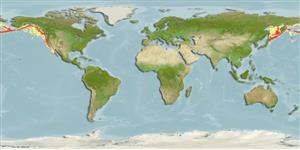>
Gadiformes (Cods) >
Macrouridae (Grenadiers or rattails)
Etymology: Albatrossia: The name of an oceanographic ship "Albatross" (1888-1900) (Ref. 45335); pectoralis: pectoralis refering to the long and narrow pectoral fin (Ref. 6885).
Eponymy: ‘Albatross’ was a steam-driven research vessel owned by the US Fish Commission. It was used for many cruises and expeditions. The greeneye species was collected when the ‘Albatross’ dredged off the coast of Japan. (Ref. 128868), visit book page.
More on author: Gilbert.
Environment: milieu / climate zone / depth range / distribution range
นิเวศวิทยา
เกี่ยวกับทะเล,น้ำเค็ม สัตว์หน้าดินในเขตน้ำลึก; ไม่มีการอพยพย้ายถิ่น; ระดับความลึก 140 - 3500 m (Ref. 50550), usually 700 - 1100 m (Ref. 56476). Deep-water; 62°N - 26°N, 143°E - 115°W (Ref. 1371)
North Pacific: northern Japan to the Okhotsk and Bering seas, east to the Gulf of Alaska, south to northern Baja California in Mexico.
Length at first maturity / ขนาด / น้ำหนัก / Age
Maturity: Lm 83.2, range 65 - 102 cm
Max length : 210 cm TL เพศผู้/กระเทย; (Ref. 56527); common length : 85.0 cm เพศผู้/กระเทย; (Ref. 56527); น้ำหนักสูงสุดที่มีการรายงาน: 86.0 kg (Ref. 56527); อายุสูงสุดที่ได้รายงาน: 56 ปี (Ref. 39270)
Short description
เครื่องมือที่ใช้ในการแยกชนิดสัตว์,สิ่งมีชีวิตออกจากกัน | สัณฐานวิทยา | ความยาวต่างๆ
เงี่ยงครีบหลัง (รวม) : 2; ก้านครีบอ่อนที่หาง (รวม) : 7 - 9; เงี่ยงครีบก้น: 0; ก้านครีบอ่อนที่ก้น: 131. Snout low, slightly protruding beyond the large mouth, without a spinous terminal scute. Scales small, slightly oblong, with moderate-sized median ridge, without spines or with few weak spinules, and 0 to 5 much lower, non-spinulated ridges laterally on exposed field. Swim bladder small, with 2 retia mirabilia. Gray-brown on head and body, each scale with a prominent dark posterior border, fins and lateral line darker; black in mouth, gill cavity, and on peritoneum (Ref. 6885). Branchiostegal rays: 6-6; pyloric caeca: 12-16;
Young apparently bathypelagic to some degree but become bathydemersal at a size of 50-60 cm (Ref. 1371). Adults feed mainly on cephalopods, fish and shrimps; other food items include ctenophores, echinoderms, worms, crabs, and amphipods (Ref. 1371). Oviparous, with planktonic larvae (Ref. 36385).
Cohen, D.M., T. Inada, T. Iwamoto and N. Scialabba, 1990. FAO species catalogue. Vol. 10. Gadiform fishes of the world (Order Gadiformes). An annotated and illustrated catalogue of cods, hakes, grenadiers and other gadiform fishes known to date. FAO Fish. Synop. 125(10). Rome: FAO. 442 p. (Ref. 1371)
IUCN Red List Status (Ref. 130435: Version 2024-2)
Threat to humans
Harmless
Human uses
การประมง: การค้า
เครื่องมือ
Special reports
Download XML
แหล่งที่มาจากอินเตอร์เน็ต
Estimates based on models
Preferred temperature (Ref.
123201): 2.2 - 3.5, mean 2.6 °C (based on 120 cells).
Phylogenetic diversity index (Ref.
82804): PD
50 = 1.0000 [Uniqueness, from 0.5 = low to 2.0 = high].
Bayesian length-weight: a=0.00087 (0.00058 - 0.00132), b=3.26 (3.13 - 3.39), in cm total length, based on LWR estimates for this species & (Sub)family-body (Ref.
93245).
ระดับชั้นอาหาร (Ref.
69278): 4.3 ±0.7 se; based on diet studies.
ความสามารถในการกลับคืนสู่ปกติ (Ref.
120179): ต่ำมาก, เวลาต่ำสุดที่จะทำให้ประชากรเพิ่มขึ้นเป็น 2 เท่าใช้เวลามากกว่า 14 ปี (tmax >30).
Fishing Vulnerability (Ref.
59153): High to very high vulnerability (70 of 100).
Nutrients (Ref.
124155): Calcium = 10.4 [5.3, 23.0] mg/100g; Iron = 0.303 [0.155, 0.627] mg/100g; Protein = 17.2 [15.5, 18.9] %; Omega3 = 0.226 [0.101, 0.496] g/100g; Selenium = 41 [17, 98] μg/100g; VitaminA = 4.24 [0.83, 19.44] μg/100g; Zinc = 0.232 [0.151, 0.366] mg/100g (wet weight);
